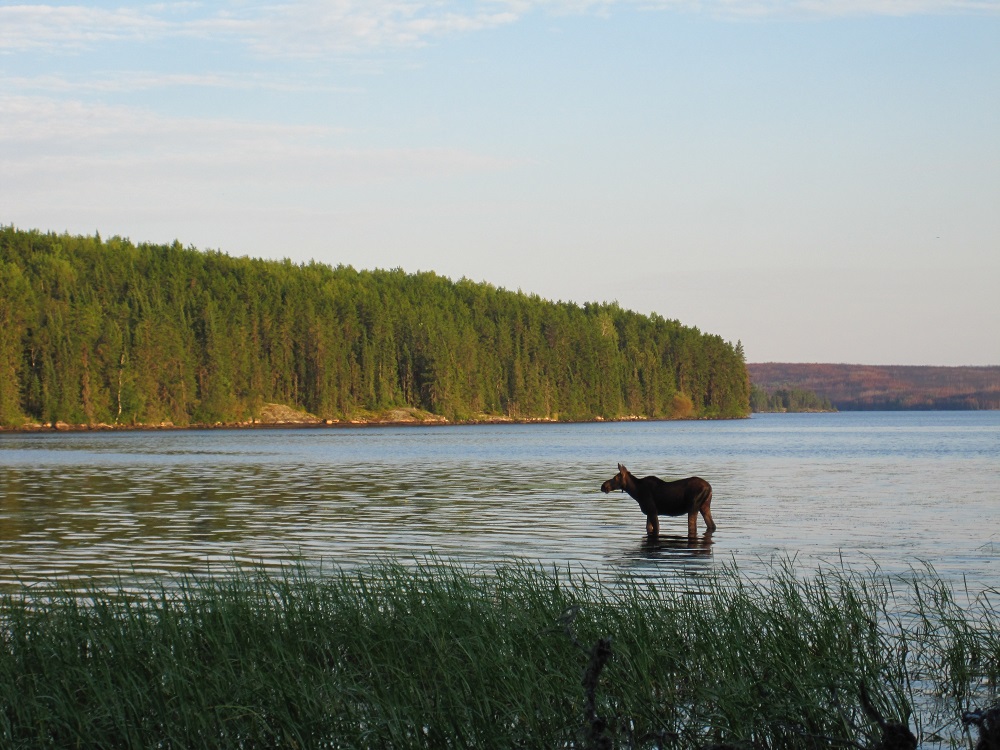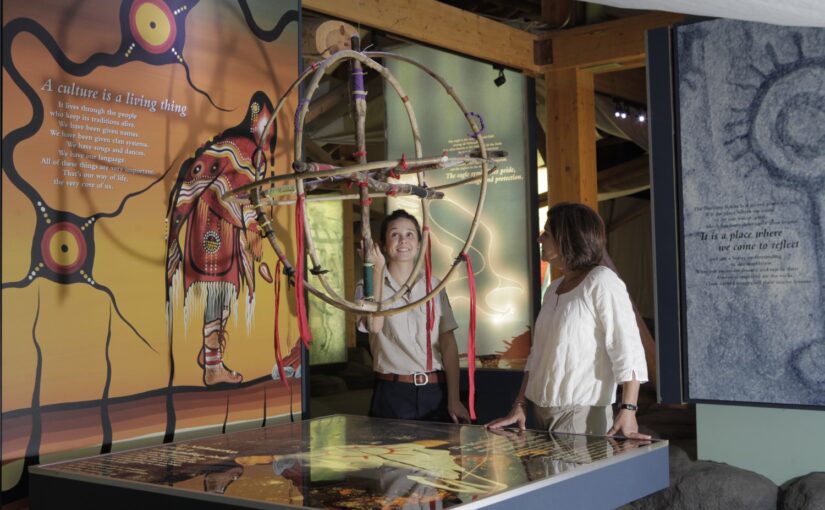Today’s post comes from DJ Fife, a park warden at Petroglyphs Provincial Park. DJ takes every opportunity available to promote the preservation of Anishinaabemowin during programs at the park and in everyday life. DJ has taught Anishnaabemowin for several semesters at Georgian College in Barrie and during several other cultural events.
To read the language, it is necessary to be aware of the writing systems used for Anishinaabemowin.
Various folk-writings have and continue to be used but the most widely used system of writing is the “Fiero” double-vowel system that is intended to be consistent and phonetic.
Below is a rough breakdown of the system.
Note that not all 26 letters of the Roman Alphabet are utilized as some sounds are absent from traditional Ojibwe (no F, L, R, V, X).
The vowels are represented thus:
a – sounds like “u” in “dud,” this sound can also occur as a schwa like the short “a” in “about” and “allow,” or think of the “e” in petunia which could almost be written p’tunia.
aa – sounds like the “a” in “father”
i – sounds like the “i” in “pit”
ii – sounds like the “ee”’ in “feet”
o – sounds like a short “o” like in “obey” and “book”
oo – can fall somewhere between “soap” and “soup,” but usually most like the “oa” in “soap”
e – sounds like the “e” in “pet,” but this can also occur with some variance in different dialects even sounding a bit like the “a” in “sat”
The consonants are represented below:
b – as in “big”
p – as in “potato”
ch – as in the “tch” in “stitch”
j – as in “jump”
d – as in “do”
t – as in “pit”
g – as in “goose,” and following an “n” sounds the same as “song”
k – as the “ck” in “sick”
h – not a common sound but the same as “h” in “hello,” some who write Anishinaabemowin also use it for a glottal stop, as in the stop on “uh-” and “oh-” in “uh oh”
m – as in “man”
n – as in “name”
s – as in “miss”
z – as in “zipper”
sh – as in “bush”
zh – as in the “s” in “measure,” or the “j” in “bonjour”
w – as in “way”
y – as in “yellow”
Some of the consonants are related (this is true in English too) and can share a level of interchangeability. Consider how it is a mere change in voicing to distinguish between many sounds: “b”/”p,” “ch”/”j”, “t”/”d,” “g”/”k,” “s”/”z,” “sh”/”zh.”
Some nasal sounds occur as well that do not really occur in English, but it is difficult to give a comparison. Additionally, people that are not used to the double-vowel system may find surprising pronunciations contrary to their expectation. One example of this is that “day,” pronounced using the double-vowel system, rhymes with the English word “mice” instead of rhyming as expected with the English word “fray.”
As a last note for those who have encountered written Anishinaabemowin, there can be some variance in how things appear in writing as a reflection of dialect.
Breaking words into syllables
Anishinaabemowin is typically spoken in “metrical feet” or a rhythmic alternation of stresses, syllable to syllable. Looking at a given Anishinaabemowin word, one can observe the regular pairing of consonants and vowels. Looking at the word “Anishinaabemowin” itself, you can break it down into vowel-consonant clusters: a-ni-shi-naa-be-mo-wi-n.
Japanese is similar in this structure. Consider familiar Japanese company names: To-yo-ta, Mi-tsu-bi-shi, To-shi-ba. The alternating stresses would be realized as a-NI-shi-NAA-be. For most southerly areas of Anishinaabemowin usage, the less stressed vowels are essentially omitted in most pronunciations. This results in the spelling and pronunciation “nishnaabemwin” that is used in many southern areas and especially on Manitoulin Island.
Essentially, the takeaway here is that “Anishinaabe” and “nishnaabe” are one and the same, just a difference in regional pronunciation.
Animate and inanimate nouns
Aside from the writing currently used, there are some interesting features about Anishinaabemowin that differ from English. In a comparable manner to French’s masculine/feminine dichotomy, Anishinaabemowin is divided between animate and inanimate.
Typically, it is fairly intuitive to determine if a noun will be animate or inanimate, but there are some unexpected animate objects and there may not always be a known explanation as to why they are animate, it is just a cultural detail that must be learned through exposure.

Obviously, a dog, tree, insect, or spirit is animate, but so too are a pot, snowshoe, ice and snow. Water, fire, table, book, arm or leg are inanimate nouns, as are conceptual nouns such as meal, language, or song.
Fourth-person
Another interesting feature of Anishinaabemowin is the Obviate or 4th person. Many English speakers would be familiar with the terms and concepts of 1st, 2nd, and 3rd person. I (1st) am telling you (2nd) about him/her (3rd person). In Algonkian languages there is also a distinction made for the 4th person (and, historically and still in some Cree, the 5th, 6th, and 7th person.).
Here is an example of how marking the 4th person works:
“John (3rd) met with Tom (4th), then he ran off”
In English, we must clarify which man ran off: “John (3rd) met with Tom (4th), then Tom ran off.”
In Anishinaabemowin, the person does not need to be reiterated. To add the Ojibwe 4th person marker “-an” (remember, this is pronounced like “-un”), we get a couple of options to say: “John met with Tom, then he ran off.”
Option 1: “John met with Tom-an, then he ran-an off,” meaning Tom ran off.
Option 2: “John spoke with Tom-an, then he ran off,” meaning John ran off.
And for those interested, the Anishinaabemowin versions of those sentences (written in a southern style, missing a couple vowels):
Option 1: “John gii-nkweshkwaan Tom-an, mii-sh gii-ni-maajiibtoowan”
Option 2: “John gii-nkweshkwaan Tom-an, mii-sh gii-ni-maajiibtoo”
Another interesting benefit of the 4th person marking is that word order can be a bit more relaxed.
You can say, “John Tom-an met, then he ran off” or “Tom-an John met,” and they are both grammatically acceptable, although some orders are more typically used.
Want to learn more?
There are many resources available to read online and in print. You can also review my other two posts on language:
